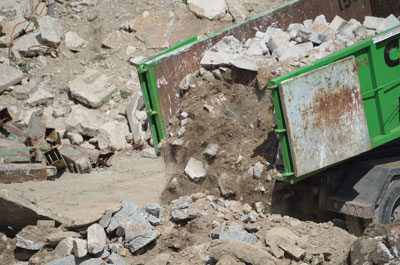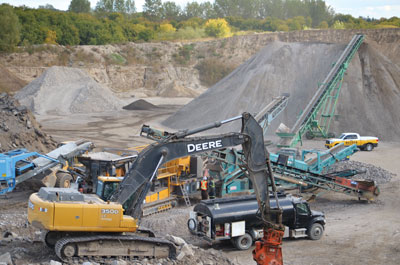
Features
Aggregates
Profiles
The Business of Recycling
Making recycled products production work for the bottom line.
December 3, 2012 By Andrew Macklin
An increased call for the use of recycled aggregates in roadbuilding
projects across Canada has caused many aggregate producers to at least
investigate the cost of making the product
An increased call for the use of recycled aggregates in roadbuilding projects across Canada has caused many aggregate producers to at least investigate the cost of making the product. But with the low cost per tonne of virgin aggregate in most if not all provinces, recycled aggregate has not always made sense for aggregate producers. Added equipment, hauling and manpower costs combine with the possibility of an inconsistent product to drive most producers away from its production.
 |
|
| Demolition crews from throughout the Kitchener-Waterloo region pay to have their aggregate and concrete products dumped at Tri City.
|
For Tri City Materials, whose base of operations is just outside of Kitchener-Waterloo in southern Ontario, producing recycled aggregate is both good for the environment and good for the company’s bottom line.
The company was founded in 2005 by president Rick Esbaugh and his brother Ron, who originally purchased the assets of A-1 Aggregates to supply aggregate to the ready-mix plant that was already a part of the Tri City operation. That acquisition, along with the purchase of the assets of Ramseyer Trucking in March 2007, has caused the company to grow its employee base to 33 while owning four local gravel pits.
It was the purchase of A-1 Aggregates that sparked the move to begin producing recycled aggregate products.
“The previous owner had large stockpiles of concrete and asphalt products, more than what we wanted to have sitting around the pit,” said Esbaugh. “So we began our recycled products operation immediately starting with the resources already on site.”
At Tri City’s Petersburg pit, the production of recycled aggregate is a process that involves 10 machines operating simultaneously. Two John Deere 350 series excavators collect the materials to be crushed. The 350D is fitted with an NPK pulverizer, which is used to remove rebar from concrete slabs that have come to Tri City from local demolition sites. Those materials are fed into a Terex Pegson XR400 portable primary jaw crusher before being fed into a TESAB RK1012TS tracked impactor, which Tri City rents from Ontario TESAB dealer Kieswetter Excavating in Heidelberg when it has large volumes of recycled products to crush.
Once the materials have passed through both crushers, the recycled product then passes through a Powerscreen Warrior 1800 heavy-duty mobile screen with three-way splitting that allows materials to be fed for secondary crushing, as well as for stacking material. Tri City uses two small Powerscreen conveyors, one to recirculate materials back to the crushers for secondary crushing, and a second to move finished product from the 1800 Warrior to the McCloskey Stacker for stacking the large piles of crushed aggregate. The operation also uses a John Deere 844J wheel loader to help move materials and a water truck to suppress dust when needed.
The 10-machine system works at a peak output of 250 tonnes/hour. That allows for efficient use of rented equipment, and getting enough material crushed in time to keep up with their current demand.
 |
|
| The lineup of equipment used in the recycling process at Tri City’s Petersburg, Ont., gravel pit.
|
“At this time of year, in the fall, is when a lot of contractors really like the product because it packs so well,” said Esbaugh. “When it rains a lot, which it does here in the fall, A gravel and B gravel will sometimes get a bit mushy. But this recycled material stands up because it has more body to it.”
Tri City Materials sometimes uses the recycled product as an alternative to both A gravel and B gravel, meeting the specs of both products. In Tri City’s recycled products, the concrete is mixed with a bit of asphalt to create both the A gravel and B gravel. The products sell at or near the same price as virgin A and B gravel, and the supply they create meets the demand that they have from their customer base.
One of the biggest customers for Tri City’s recycled materials is a local municipality, who uses the products to provide solutions for some of its infrastructure needs.
“The Region of Waterloo buys a lot of our A gravel for shouldering roads,” said Esbaugh. “In this area, there are Mennonite horse and buggies around, and the A gravel stands up well to that because there’s not as much grading. The Region also uses the recycled concrete as well in their landfill, for ballast to get their trucks over and to build roads with it.”
Producing the supply to meet local demand isn’t the only part of the financial solution for producing recycled aggregate. Creating recycled aggregate products also comes with a cost on the front end, which is paid by the companies looking to dispose of the asphalt and concrete. Even with other options for the disposal of concrete and asphalt in the municipality, Tri City has positioned itself as the most cost-effective solution for getting rid of recycled products.
“We’ve got lots of demolition going on, so we get lots of concrete products,” said Esbaugh. “We also get a lot of bin customers who bring concrete here. Rather than take it to the landfill and pay one price, they bring it here and pay much less.”
The successful business model for recycled aggregate production also helps to address another important aggregate issue in the region: shortages of rock supply. Many parts of south-central Ontario have heavy sand deposits, and finding the quality aggregate within that sand can cost too much to be practical given today’s POS for aggregate tonnage. So recycling quality rock to replace shrinking virgin supplies is a good solution for keeping up with demands for aggregate.
“In the area we’re in, there’s always a shortage of stone,” said Esbaugh. “There’s lots of sand in this area. By producing recycled aggregate products, we can keep our stone reserves and we can use up our sand. It’s a good balance and the recycled aggregate makes a great product.”
Tri City continues to promote the use of recycled aggregate in community roadbuilding projects, inviting members of regional municipalities to an open house, and speaking about the need for increased use of the materials at the Aggregate Resources Act hearings held in early July. With an increasing number of community advocacy groups calling for a reduction in virgin aggregate production, the production of recycled products is helping Tri City to work with existing supplies, rather than join the number of aggregate companies fighting for new pit projects and current pit expansions to meet the demands of southern Ontario.
At the end of the day, producing recycled aggregate products meets the demands of Esbaugh’s clients and the demands on his bottom line. He believes that his market is not the only market that can benefit from the production of recycled aggregate products.
“If you’re not making recycled products, your business is really missing something.”
Print this page